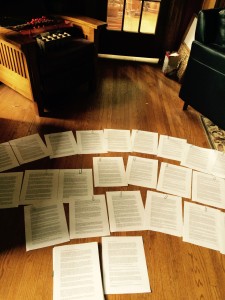About 8 years ago (! yikes!), I belonged to a toxic “social” web site, where the main focus was to be creative, but often the vibes were twisted and borderline abusive. Sometimes scary. However, as with most conditions of the human kind (and some of the cyber ones), there was an upside to contributing to the site. For one thing, my years spent on it charged my creative juices. The friendly (and not-so) banter challenged my thinking. I started writing again, after a long hiatus of taking care of children.
My writing was horrible at first, but having been at different times an English and a journalism major, at least my grasp of grammar was better than most. I hadn’t thought about the mechanics of writing in a long time.
But this web site was self-regulating, by Grammar Police. Some of the critiques were friendly, thank God, otherwise I might have given up writing altogether.
During my last years in, I started writing a serial story about a precocious teenager in mid-1970’s Minnesota. The story started as a lark, an outrageous forty-five minute writing exercise a day of my protagonist’s rather outlandish adventures. After a while, I liked Sioux C. She was me, but with balls. I peppered her neighborhood with my cousins, my boyfriends, and my dreams. I wrote about her as a 20 year old party girl, and I wrote about her as a 45 year old has-been with regrets.
One day, the aforementioned web site appeared to be going down the drain. I was naive back then, and would write directly into the site, never putting my words into a Word document or even printing them out. But the writing was on the wall, and this good time wasn’t going to last long. Before I committed social network suicide, I painstakingly copied and pasted all of the stories into a Word document and erased all traces of her. I started a WordPress blog with the intent of continuing the story there.
In the meantime, I began writing other novels, four and half more. I put Sioux C on a shelf. This was easy, as there really wasn’t any ending to the story. Until a month ago…
Yeah, the light bulb went off above my head, just like in the cartoons.
Now that I had a story line, I decided to dredge up my document and paperclip it, using Michelle Richmond’s technique. Imagine my dismay when I couldn’t find my file!
I use Carbonite (thank you), which I have said many times that it’s the best $50 a year I spend. It’s saved me so many times. I had to dig back into the archives a little, since the last incarnation of the novella was three laptops ago, but I did find it.
(YAY!)
It was easy enough to print out. Paperclipping, that’s another story.
I can see now that I have to weave my story line in, and end it to my satisfaction. I can also see that I need to add more dialogue (I hated to write dialogue back then), straighten out more bumps, delete some, etc. I don’t know if I can use the stories I wrote of her in her 20’s or at 45, but that’s a bridge I can cross when I come to it.
These are the things you as a writer can learn from this story:
1. Never throw any writing away. You don’t know if it will come in handy. Maybe not all of it, but everything you have expended energy on has value.
2. Get online cloud storage. I have referred to Carbonite as the granny hoarder of the Internet that doesn’t throw anything out. That’s what you need.
3. Occasionally print your story out. Look at it on paper. Speak it out loud.
4. Buy pretty paper clips. The ones I had in my drawer seem too industrial. Then again, that’s the look I was going for.
Now, to get busy.








